
BLOIS CASTLE
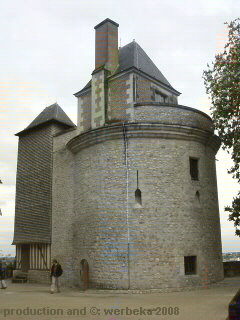 |
Blois is different, compared to the other castles in the Loire-valley. Here you can have an overview of the history of architecture - from the 13th to the 17th century, while the castle was built in different stages. From the beginning there was a Gothic house, part of which today is situated between the late Gothic wing and the wing from the Renaissance. That was a part of the castle of the Earls of Blois. Together with the wall and the Tour de Foix (on the picture to the left) they are the oldest parts of the castle. The patio has been hightened throughout the centuries, so that one has to climb down some steps, in order to enter the tower. It is empty, but it is situated at the hightest point of the castle, which gives a brilliant view from there.
Today the castle lies in the midst of the city, which has grown nearer from all directions. From the roofs of the houses one can judge, how high above the castle really is. The St. Nicholas-church right across is another splendid view. |
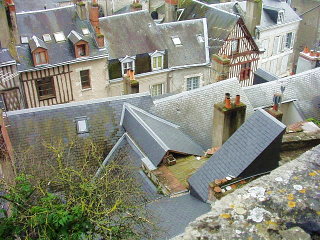 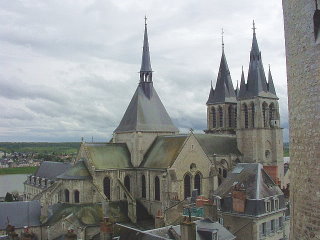
But the patio has more to show, than only the view: Stacked slingshot-balls from the 15th century make one realize how sieges were fought. The balls are made of limestone, which was found within the castle's area.
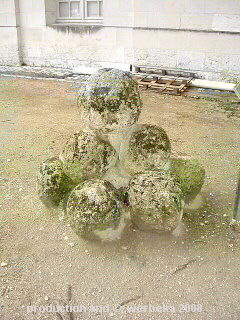 |
They have a diameter of about 40 - 50 cm, because one needed very much force, to do any damage with balls of stone. Only when iron canonballs could replace them, the results were "better".
Much more pleasant is the statue of Pan with his goatleg and the panpipe, being about to seduce an nymph. The panpipes were invented in a similar situation - when he tried to seduce the nymph Syrinx. |
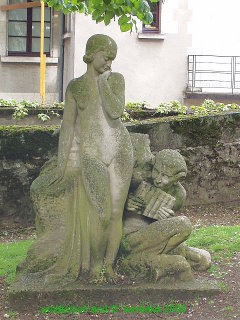 |
But she transformed herself into reed, before he could get hold of her. Then Pan cut some reed and made the panpipe of it.
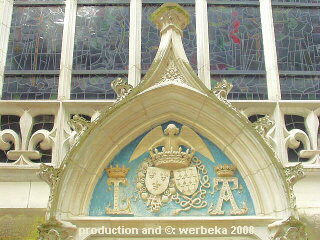 |
On our way back to the inner courtyard we pass the castle's chapel, which was built by Louis XII and consecrated to St. Calais in 1507. Above the entrance one can see the initials L for the King and A for Anna de Bretagne, his wife. The premises for this marriage were worse than any soapopera on TV today, though.
Louis XII was 14 years old, when he married his 12 year old cousin, Jeanne de Valois, daughter of Louis XI. The latter was very much in favour of this bonding with a potential heir to the throne. His own son, Charles VIII, had in the meantime married Anna de Bretagne. But Anna had in the year before married the Hapsburg Maximilian I. |
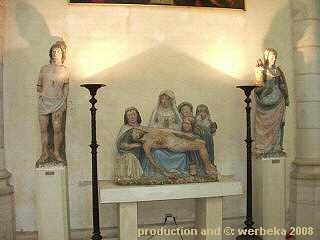 Lamentation of Christ, wood carving in the chapel Lamentation of Christ, wood carving in the chapel |
At the wedding Count Polheim acted stand-in for Maximilian, who didn't want to make the long journey and who wasn't as interested in Anna, as he was in Brittany. France protested, because according to an agreement, it would have been necessary to have the consent of the French King for this marriage. Three months later French soldiers occupied Brittany. Maximilian didn't send any troops or even financial support to his spouse, who after eight months of house arrest accepted to meet Charles VIII. Three weeks later those two married, because the marriage between Anna and Maximilian never had been fulfilled. But actually it was much worse still ...
|
Eight years earlier Charles VIII had married the then three year old daughter of Maximilian. Naturally even this marriage never had been fulfilled and could be cancelled. This was a somewhat cumbersome situation for Maximilian. At the same time he lost his wife to his son in law and the husband of his daughter. No wonder, that the relations between France and Austria not really were the best.
But the story continues ... When Charles died without children at the age of only 28, Louis XII became King of France overnight. If it now was him, who was interested in Anna, or Anna in him, we can't be sure of - but the trouble was that he had been married to Jeanne de Valois for 23 years. However, Louis XII convinced Pope Alexander VI, that even his marriage never had been fulfilled - and he got the divorce. Three weeks later and only nine months after the death of Charles VIII he married Anna.
Jeanne de Valois became duchess and got the duchy Berry in compensation.
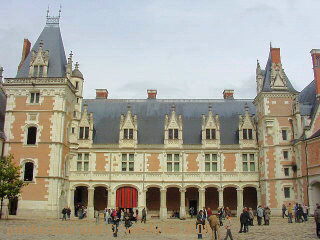 |
But from all those scandalous stories back to the history of the castle. Already in the 9th century there was a castle at Blois. It were the Earls of Blois, who owned it - until the year 1230, when the family Châtillon inherited it. In the 14th century the castle is mentioned as the "most beautiful castle in the kingdom". In 1391 it was sold to Duke Louis de Orléans, the grandfather of Louis XII.
Even the father of Louis XII has written some tragic history. He was taken prisoner by the English in the Hundred Years War and sat 25 long years in England, because the King, his cousin, didn't pay the ransom. |
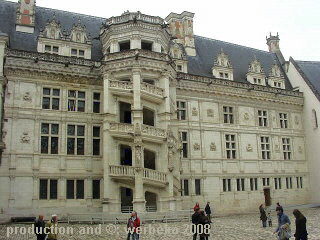 |
After his return the 46 year old married the only 14 year old Maria von Kleve - the mother of Louis XII. Those two educated people organised poetic games in the castle of Blois, in which everybody could participate.
Whe he had become king, Louis XII built the main wing of the castle in late Gothic style, as well as the sidewing in front of the chapel.
In 1515 Louis XII died and his cousin Francis I, married to a daughter of Louis, became king. He built the second sidewing, but this already in Renaissance style, which he had been impressed of in Italy. |
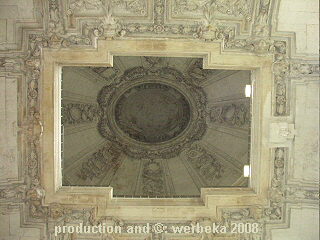 |
The last wing, opposite to the entrance, was finally built by Gaston d'Orléans in Neoclassical style, where earlier the "apartment house" of Anna de Bretagne had stood. The double cupolas in the staircase are doubtless worth a glance upwards. And the manifold styles, which at the first view might be a little distressing, become a plus together with the insight, that one here can get a very unusual, architectural overview.
But Blois still has some more surprises. |
On the second floor of the main wing there is an Art Museum, showing works with emphasis on ancient times as well as biblical an mythological content. Paintings and sculptures from the 16th to the 19th century are shown here, as well as an important collection of tapestry.
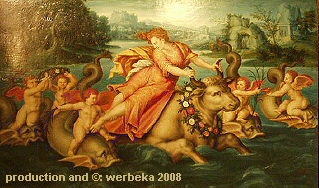
Europa is brought to Crete by Zeus in the shape of a bull |
|
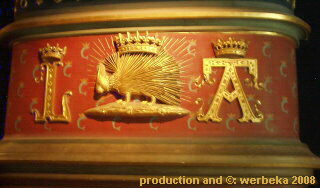
The porcupine was the heraldic animal of Louis XII |
Above the fireplaces there are reconstructions of different emblems of Louis XII and Anna de Bretagne, taken out of the Queen's book of hours. The original of which today is kept in the National Library of France.
The round tour is marked with arrows, showing in which direction to go, so that one can manage without guide. It starts in the oldest part of the castle, in the Gothic House, where there is the Hall of State, a chamber, which was build before 1220. The two-aisled hall is steadied in the middle by a row of pillars. This is the biggest Gothic chamber in France, remaining from the 13th century. The colouring and the painting of the ceiling is most impressive. On a deep blue background there are thousands of French lilies to be seen, glowing like stars. Though this is a restauration from the 19th century, it is said, that it should have looked like that in the 13th century as well.
During the Middle Ages court was held here. The hall got its name, because the King here summoned the representatives of the Estates-General in the years 1576 and 1588.
The tour continues into the Renaissance wing of Francis I, namely into the kitchen, where there yet waits another surprise. |
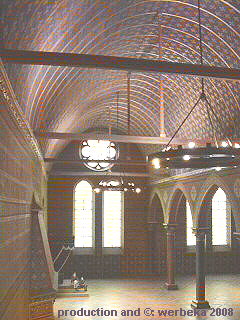 |
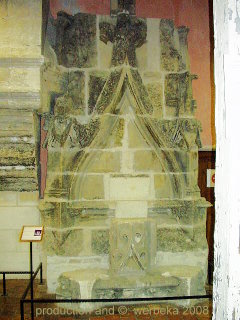 |
Here, there is a lapidarium. The word comes from Latin "lapis", meaning "stone".
That means, that this is a collection of stones, but not a collection of minerals, but of worked stones. In this case the stones are part of the castle itself, which was going to be destroyed under Louis XVI. The work had already started, when it was decided to make barracks of the castle. In 1840 one decided finally, that the castle was to be a historical monument and started to restore it. What is to be seen here in the Lapidarium, are parts, which already were torn off, but which luckily still were to be found. Here you can see fragments of the sidewing of Louis XII, that is to say parts of the eaves and a pinnacle.
Nobody knows how the rest of the rooms were arranged. The restaurator of the castle, Félix Duban, supposed an "ideal" arrangement of the rooms, when he reconstructed them.
|
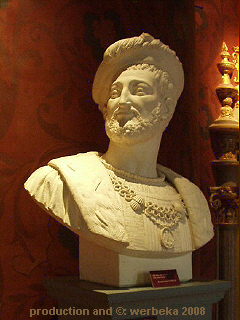 |
We start in the dwelling of Francis I, where we today can find a bust of this eversmiling king, as well as his heraldic animal, the crowned salamander, above the door. A canopy underlines once more the grandeur of the king.
In the following hall of the guards, weaponry from the 15th through the 17th century is shown. Via the gallery you reach the bedroom of Catharina de Medici. |
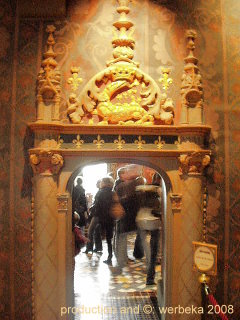 |
|
She was the spouse of Henry II, the son and successor of Francis I, and a big schemer, as well as mother of three subsequent kings Francis II, Charles IX and Henry III.
The small, following studio is the only room in the castle, which has survived the centuries reasonably well, and more or less looks like it did 500 years ago. 237 graven panels, with patterns of Italian candelabra, form the panelling of the walls and four cupboards hold works of art from the Renaissance.
The various pieces of furniture in the castle are almost all held in the Renaissance style, but replicas from the 19th century, when the castle was restaurated.
On the third floor one finds rooms as they might have looked at the era of Henry III (1574 - 1589). |
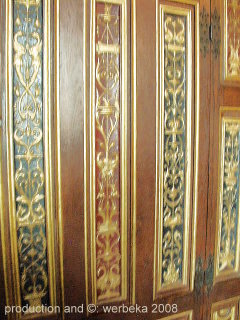 |
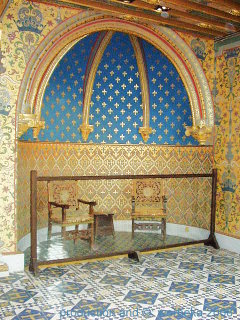 |
Henry III was a weak king in a difficult time. The war between protestants and catholics was still going on after the St. Bartholomew's Day massacre - and the King tried to calm both parts. But he didn't do it by staying neutral. He fell from one side to the other, which increased the difficulties. The Catholic League on the other hand gained more and more power. |
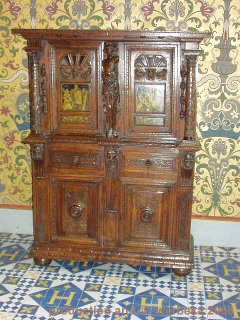 |
| Their leader was Henry de Guise, who marched into Paris in triumph and made the King flee to Blois. But he didn't fulfill the coup d'etat. He sought a compromise with Henry III. But the King asked him to come into his private chambers at Blois, half a year later, where he had him killed by his guards. Just to be sure, he even murdered the brother, Cardinal de Guise. Another six months later, Henry III himself was the victim of a murderer, the monk Clément.
Even the furniture in the King's Chamber (seen here on the photos) is not the original one, but consists of reproductions from the 19th century. Though the room might have been the place for the murder of Henry de Guise.
© Bernhard Kauntz, Västerås 2008
|
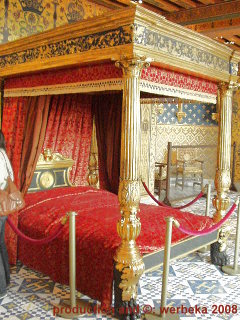 |
Back to  or to the or to the  of of 
last update: 26.5.2008 by webmaster@werbeka.com
|






















